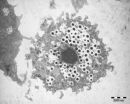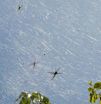(Press-News.org) It seems as if a tumor deprived of oxygen would shrink. However, numerous studies have shown that tumor hypoxia, in which portions of the tumor have significantly low oxygen concentrations, is in fact linked with more aggressive tumor behavior and poorer prognosis. It's as if rather than succumbing to gently hypoxic conditions, the lack of oxygen commonly created as a tumor outgrows its blood supply signals a tumor to grow and metastasize in search of new oxygen sources – for example, hypoxic bladder cancers are likely to metastasize to the lungs, which is frequently deadly. A University of Colorado Cancer Center study recently published in the journal Cancer Research details a mechanism by which these hypoxic conditions create aggressive cancer, with possible treatment implications for cancers including breast, ovarian, colorectal, pancreatic, prostate, bladder and other cancers.
"We've known that the protein HIF-1a is overexpressed in hypoxic tumors. And we've known that the cancer stem cell marker CD24 is overexpressed in many tumors. This study shows a link between the two – the HIF-1a of hypoxia creates the overexpression of CD24. And it's this CD24 that creates a tumor's aggressive characteristics of growth and metastasis," says Dan Theodorescu, MD, PhD, director of the University of Colorado Cancer Center and the paper's senior author.
Outgrowing the blood supply leads to tumor hypoxia, which leads to overexpression of HIF-1a, which signals the production of CD24, which makes tumors grow and metastasize. In addition to aggression, CD24 has also been shown to confer resistance to chemotherapy, allowing this small population of cells to regrow the tumor once chemotherapy ends, leading to relapse and disease progression.
"Now imagine we target CD24," Theodorescu says. "Either by removing a cell's ability to make CD24 or by killing cells marked by this protein, it's likely we could disarm this most dangerous population of cells."
Theodorescu and colleagues showed this by adjusting levels of HIF-1a and CD24 in cancer cell samples and animal models. With HIF-1a low and yet CD24 artificially high, cells retained the ability to grow and metastasize. With CD24 low and yet HIF-1a artificially high, cell survival and proliferation decreased.
"It seems CD24 overexpression in hypoxic cells drives growth and metastasis in these hypoxic tumors," Theodorescu says. "Now we have a rational target: CD24 for these hypoxic tumors."
### END
Lack of oxygen in cancer cells leads to growth and metastasis
CD24 is a rational target in hypoxic cancers
2012-09-13
ELSE PRESS RELEASES FROM THIS DATE:
Laser-powered 'needle' promises pain-free injections
2012-09-13
VIDEO:
The movie shows the injector firing into open air without a skin or gel target. The jet, which is approximately the diameter of a human hair, seems dispersed but a...
Click here for more information.
WASHINGTON, Sept. 13—From annual flu shots to childhood immunizations, needle injections are among the least popular staples of medical care. Though various techniques have been developed in hopes of taking the "ouch" out of injections, hypodermic needles are still the ...
IU chemist develops new synthesis of most useful, yet expensive, antimalarial drug
2012-09-13
BLOOMINGTON, Ind. -- In 2010 malaria caused an estimated 665,000 deaths, mostly among African children. Now, chemists at Indiana University have developed a new synthesis for the world's most useful antimalarial drug, artemisinin, giving hope that fully synthetic artemisinin might help reduce the cost of the live-saving drug in the future.
Effective deployment of ACT, or artemisinin-based combination therapy, has been slow due to high production costs of artemisinin. The World Health Organization has set a target "per gram" cost for artemisinin of 25 cents or less, but ...
Study of giant viruses shakes up tree of life
2012-09-13
CHAMPAIGN, Ill. — A new study of giant viruses supports the idea that viruses are ancient living organisms and not inanimate molecular remnants run amok, as some scientists have argued. The study reshapes the universal family tree, adding a fourth major branch to the three that most scientists agree represent the fundamental domains of life.
The new findings appear in the journal BMC Evolutionary Biology.
The researchers used a relatively new method to peer into the distant past. Rather than comparing genetic sequences, which are unstable and change rapidly over time, ...
Scientists use sound waves to levitate liquids, improve pharmaceuticals
2012-09-13
It's not a magic trick and it's not sleight of hand – scientists really are using levitation to improve the drug development process, eventually yielding more effective pharmaceuticals with fewer side effects.
Scientists at the U.S. Department of Energy's (DOE) Argonne National Laboratory have discovered a way to use sound waves to levitate individual droplets of solutions containing different pharmaceuticals. While the connection between levitation and drug development may not be immediately apparent, a special relationship emerges at the molecular level.
At the molecular ...
Increased dietary fructose linked to elevated uric acid levels and lower liver energy stores
2012-09-13
Obese patients with type 2 diabetes who consume higher amounts of fructose display reduced levels of liver adenosine triphosphate (ATP)—a compound involved in the energy transfer between cells. The findings, published in the September issue of Hepatology, a journal of the American Association for the Study of Liver Diseases, indicate that elevated uric acid levels (hyperuricemia) are associated with more severe hepatic ATP depletion in response to fructose intake.
This exploratory study, funded in part by grants from the National Institute of Diabetes and Digestive and ...
Poorest miss out on benefits, experience more material hardship, since 1996 welfare reform
2012-09-13
Although the federal government's 1996 reform of welfare brought some improvements for the nation's poor, it also may have made extremely poor Americans worse off, new research shows.
The reforms radically changed cash assistance—what most Americans think of as 'welfare'— by imposing lifetime limits on the receipt of aid and requiring recipients to work. About the same time, major social policy reforms during the 1990s raised the benefits of work for low-income families.
In the wake of these changes, millions of previous welfare recipients, largely single mothers, ...
Mutation breaks HIV's resistance to drugs
2012-09-13
The human immunodeficiency virus (HIV) can contain dozens of different mutations, called polymorphisms. In a recent study an international team of researchers, including MU scientists, found that one of those mutations, called 172K, made certain forms of the virus more susceptible to treatment. Soon, doctors will be able to use this knowledge to improve the drug regiment they prescribe to HIV-infected individuals.
"The 172K polymorphism makes certain forms of HIV less resistant to drugs," said Stefan Sarafianos, corresponding author of the study and researcher at MU's ...
UMD study shows exercise may protect against future emotional stress
2012-09-13
Moderate exercise may help people cope with anxiety and stress for an extended period of time post-workout, according to a study by kinesiology researchers in the University of Maryland School of Public Health published in the journal Medicine and Science in Sports and Exercise.
"While it is well-known that exercise improves mood, among other benefits, not as much is known about the potency of exercise's impact on emotional state and whether these positive effects endure when we're faced with everyday stressors once we leave the gym," explains J. Carson Smith, assistant ...
Snakes minus birds equals more spiders for Guam
2012-09-13
HOUSTON -- (Sept. 13, 2012) -- In one of the first studies to examine how the loss of forest birds is effecting Guam's island ecosystem, biologists from Rice University, the University of Washington and the University of Guam found that the Pacific island's jungles have as many as 40 times more spiders than are found on nearby islands like Saipan.
"You can't walk through the jungles on Guam without a stick in your hand to knock down the spiderwebs," said Haldre Rogers, a Huxley Fellow in Ecology and Evolutionary Biology at Rice and the lead author of a new study this ...
Under-twisted DNA origami delivers cancer drugs to tumors
2012-09-13
Scientists at Karolinska Institutet in Sweden describe in a new study how so-called DNA origami can enhance the effect of certain cytostatics used in the treatment of cancer. With the aid of modern nanotechnology, scientists can target drugs direct to the tumour while leaving surrounding healthy tissue untouched.
The drug doxorubicin has long been used as a cytostatic (toxin) for cancer treatment but can cause serious adverse reactions such as myocardial disease and severe nausea. Because of this, scientists have been trying to find a means of delivering the drug to the ...
LAST 30 PRESS RELEASES:
Air pollution linked to more severe heart disease
Where the elements come from
From static papers to living models: turning limb development research into interactive science
Blink and you will miss it: Magnetism switching in antiferromagnets
What’s the best way to expand the US electricity grid?
Global sports industry holds untapped potential for wildlife conservation
USF-led study reveals dramatic decline in some historic sargassum populations
Fullerenes for finer detailed MRI scans
C-Compass: AI-based software maps proteins and lipids within cells
Turning team spirit into wildlife action
How influenza viruses enter our cells
New camera traps snap nearly three times more images of endangered Sumatran tigers than before
Survey: Nearly all Americans not aware midwives provide care beyond pregnancy, birth
Fearless frogs feast on deadly hornets
Fibulin-5: A potential marker for liver fibrosis detection
Development of 'OCTOID,' a soft robot that changes color and moves like an octopus
Marriage, emotional support may protect against obesity through brain-gut connection, study finds
High-speed all-optical neural networks empowered spatiotemporal mode multiplexing
High-energy-density barocaloric material could enable smaller, lighter solid-state cooling devices
Progresses on damped wave equations: Multi-wave Stability from partially degenerate flux
First discoveries from new Subaru Telescope program
Ultrafast laser shock straining in chiral chain 2D materials: Mold topology‑controlled anisotropic deformation
Socially aware AI helps autonomous vehicles weave through crowds without collisions
KAIST unveils cause of performance degradation in electric vehicle high-nickel batteries: "added with good intentions
New ECU tool can help concussion patients manage fear and improve recovery
People with diabetes face higher risk of sudden cardiac death
Breast density notification increases levels of confusion and anxiousness among women
K’gari’s world famous lakes could be at risk of drying
Airplane and hospital air is cleaner than you might think
Concern over harmful medical advice from social media influencers
[Press-News.org] Lack of oxygen in cancer cells leads to growth and metastasisCD24 is a rational target in hypoxic cancers



